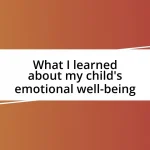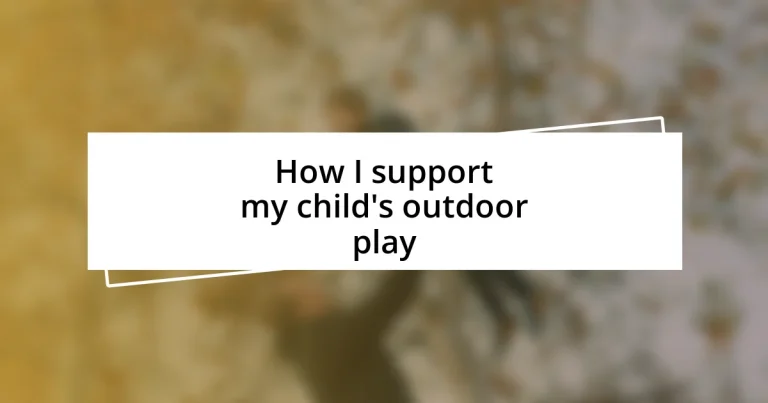Key takeaways:
- Outdoor play fosters physical health, creativity, and emotional well-being in children, making it essential for their development.
- Choosing safe play environments and setting clear boundaries enhances children’s security while allowing them to explore freely.
- Engaging with children during outdoor activities through questioning and participation deepens bonds and encourages exploration and creativity.
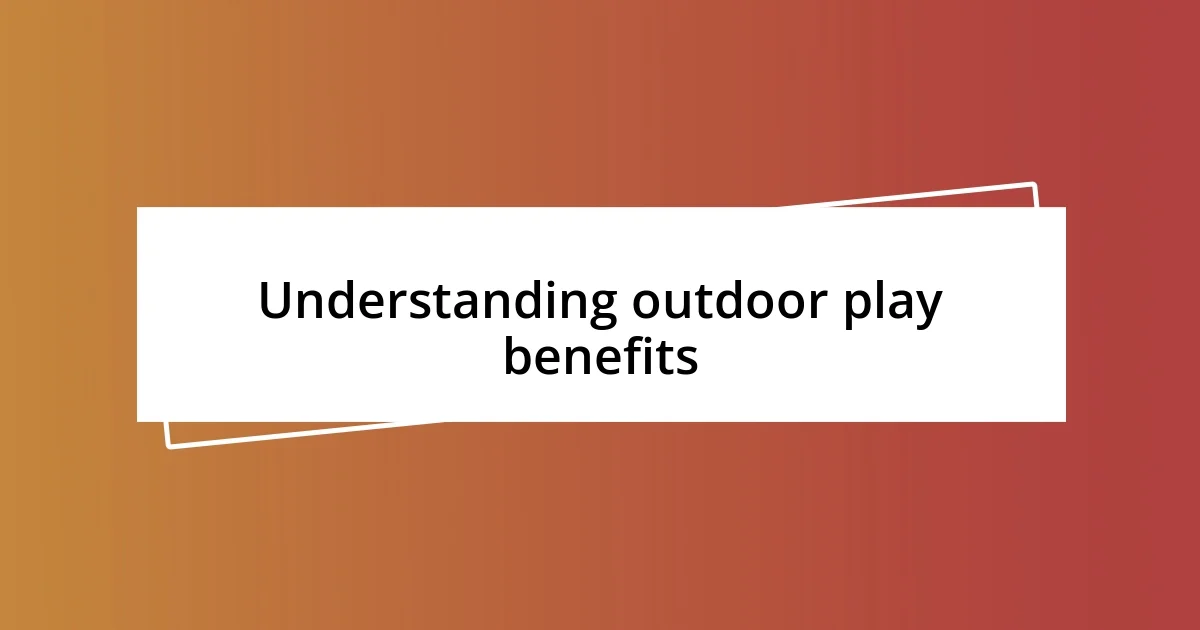
Understanding outdoor play benefits
When I watch my child play outside, it often feels like witnessing a tiny miracle. The benefits of outdoor play extend far beyond just having fun—it’s crucial for their physical health, too. Jumping, running, and climbing not only strengthen their muscles but also improve coordination. Isn’t it fascinating how something as simple as a game of tag can set the foundation for a lifetime of fitness?
I’ve noticed that outdoor play also sparks creativity in ways that indoor activities can’t. Just the other day, my daughter gathered sticks and leaves to build a “magic fortress” in the backyard. It reminded me about how nature can serve as an endless canvas for imagination. When children are outdoors, they learn to invent games and narratives, cultivating both their creativity and problem-solving skills.
Moreover, the emotional benefits of outdoor play are profound. Playing in open spaces with friends creates bonds that help build social skills, such as communication and teamwork. I cherish the laughter I hear when my child plays with peers—it’s pure joy that fuels their spirit. Do you remember the simple pleasures of just being free outside? I believe giving children that freedom allows them to explore not just the world around them, but also who they are.
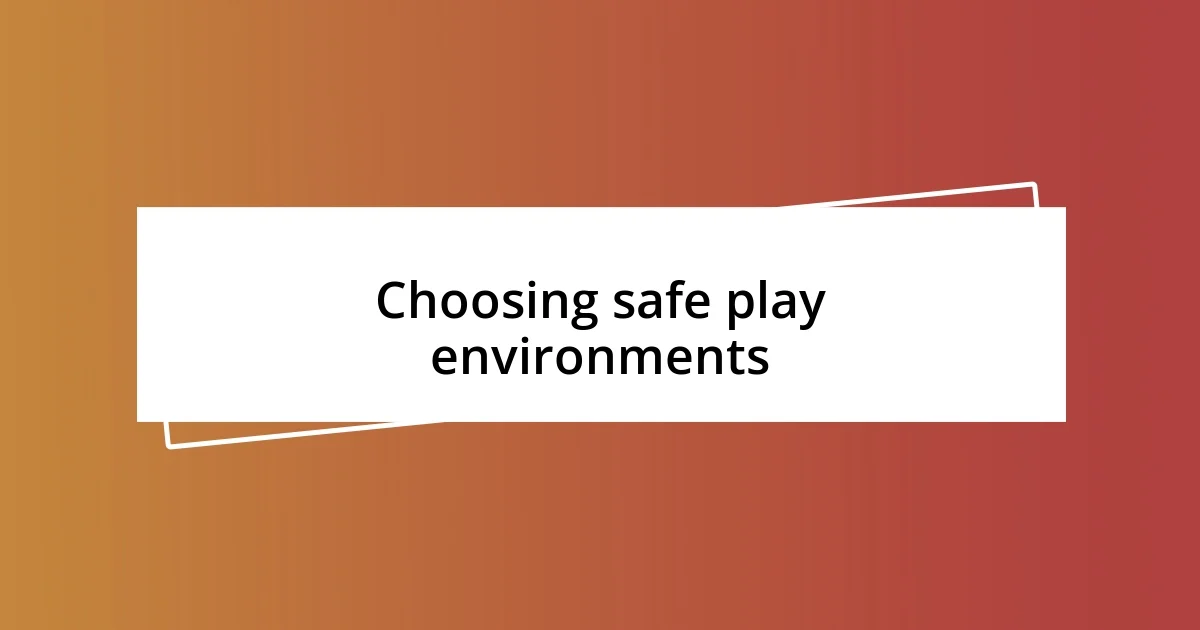
Choosing safe play environments
Choosing safe play environments is essential for ensuring that outdoor experiences remain joyful and enriching for my child. I’ve learned to carefully evaluate the space where my child plays, keeping in mind not just the fun factor but also the safety of the surroundings. For instance, I always check for sharp objects or hazardous materials, as well as look out for well-maintained equipment. Just the other afternoon, as we explored a new park, I felt a wave of relief knowing that the swings and slides had soft ground cover. It made it easier for me to allow my child the freedom to play without worry.
Here are some key considerations I keep in mind when selecting a play environment:
– Inspect the Area: Look for any potential hazards like broken glass, exposed roots, or uneven surfaces.
– Safety Features: Ensure play equipment has adequate safety measures, such as guardrails and soft surfacing.
– Supervision Opportunities: Choose spots where I can easily supervise my child while they play.
– Age Appropriateness: Select areas designed for my child’s age, which can enhance their experience and safety.
– Community Feedback: Listen to others in our community about safe places they trust for their kids.
It’s so reassuring to know that I can take steps to ensure a safe environment. Watching my child explore a safe space without hesitation brings me a sense of peace that enhances both their fun and my enjoyment as a parent.

Encouraging exploration and creativity
To encourage exploration and creativity in children’s outdoor play, I often create an inviting atmosphere filled with opportunities for them to innovate. By setting up a designated area in the yard with various materials like cardboard boxes, colored chalk, and natural elements, I see how my child takes the lead. Just the other day, I found her transforming a cardboard box into a spaceship, complete with decorations. It struck me that giving her the freedom to explore was as important as providing the tools. It’s simply magical to watch their imagination soar in the great outdoors.
I believe that participating alongside my child can amplify their creative play. Engaging in activities, whether it’s helping her build a fort or joining in a scavenger hunt, fosters a sense of collaboration. One time, we spent an afternoon collecting interesting stones from the park and later used them to create a colorful garden pathway at home. This shared experience didn’t just spark her creativity; it also deepened our bond. It’s moments like these that remind me that outdoor play isn’t just about physical activity; it’s about nurturing connections and imaginative thinking.
In addition to providing materials and participating in play, I try to encourage questioning and exploration. When my child wonders why a tree has different colors in its leaves or asks how ants build their homes, I see this as an opportunity for adventure. I often take these moments to explore further together. Remember that day we followed an ant trail, trying to understand their little world? It filled my heart with joy to see her curiosity unfold. These interactions foster a mindset where exploration becomes second nature, all while keeping the simplicity and wonder of nature at the forefront of her playtime.
| Encouragement Method | Description |
|---|---|
| Designated Play Areas | Creating spaces with materials to foster imagination and exploration. |
| Participation | Joining in on activities to strengthen bonds and inspire creativity. |
| Encouraging Questions | Using curious moments to explore and learn about the natural world together. |
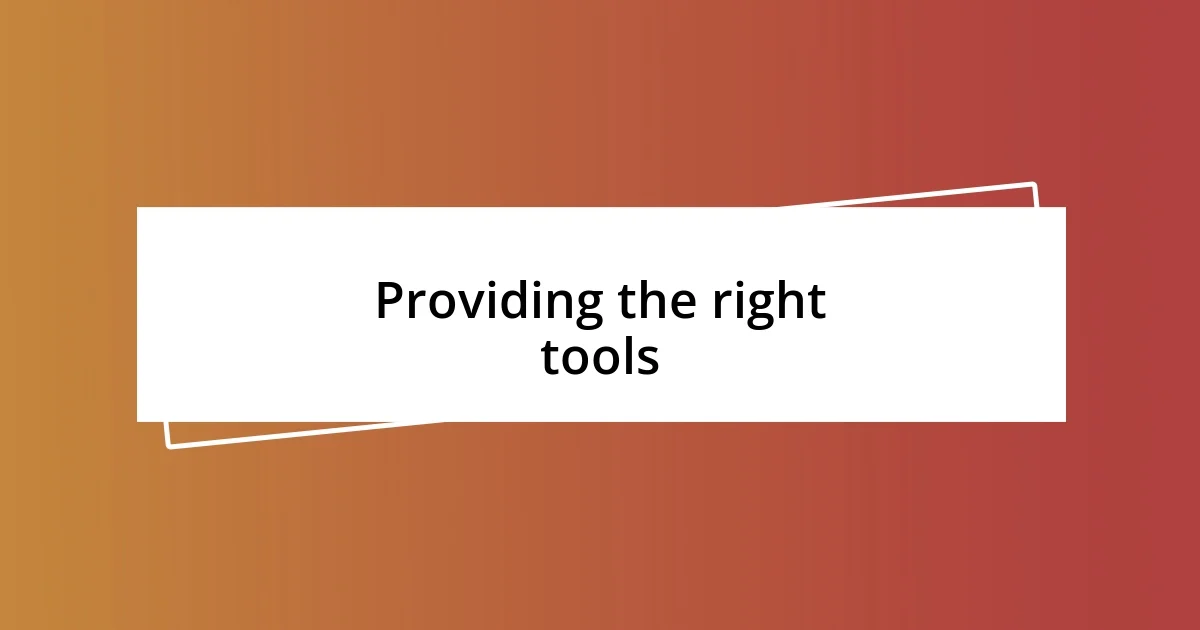
Providing the right tools
When it comes to providing the right tools for my child’s outdoor play, I find that versatility is key. Just last weekend, we ventured out with a simple set: a frisbee, some bubbles, and a couple of hula hoops. It amazed me how these basic items could spark so much creativity and excitement. I often ask myself, “What could we create today with just a few simple tools?” This mindset helps me appreciate how little can turn into so much when the imagination is at play.
Incorporating various items can also enhance my child’s sensory experiences. I love introducing things like textured fabrics or natural materials, like pine cones and leaves, into their play. One afternoon, we used soft scarves for a parachute game, and watching her experiment with the feel of the material in the breeze was truly delightful. It wasn’t just about having more toys; it was about inviting her to explore textures and patterns in a way that adds depth to her outdoor experiences.
I can’t emphasize enough how important it is to keep the tools age-appropriate and engaging. I remember a time when my child became disinterested in a large playground structure because it felt intimidating. To remedy that, I brought a simple kite to the park instead. The joy on her face as she flew it for the first time was priceless. It made me realize that sometimes the best tools are those that create genuine moments of joy and connection. Does your child have a favorite outdoor tool? For me, it’s about discovering together what truly makes them light up with a spark of joy.
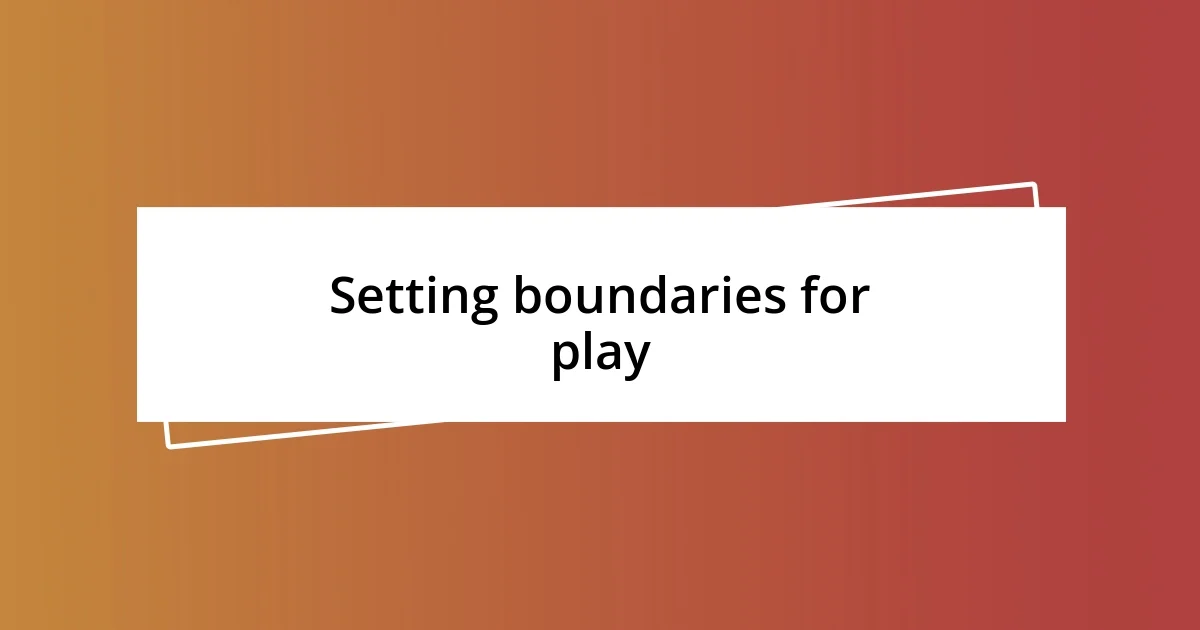
Setting boundaries for play
Setting boundaries for play is crucial for ensuring a safe and enjoyable experience. I’ve learned that clear guidelines help my child understand what is acceptable, whether it’s about setting limits on the distance they can roam or defining which areas are for wild exploration and which are for more structured activities. One sunny afternoon, I watched as my daughter ran towards a small creek. I felt a twinge of worry that she might slip, so I gently reminded her of our boundary: “You can explore, but please stay on the path near the water.” This way, she could still enjoy nature while being mindful of her safety.
It’s also important to watch for signs of frustration or confusion. I remember a time when my child ventured too far into a play area filled with older kids, and she seemed unsure of how to engage. Sensing her hesitation, I encouraged her to come back to the designated play zone we had set up earlier. “Why not come back and help me build that fort we talked about?” I asked. She promptly returned, and I could see the relief on her face as we built together. Establishing and respecting these boundaries allows her to safely test her limits while still feeling secure.
I find that boundaries also open up room for negotiation and learning. Sometimes, my child challenges the rules: “But why can’t I try swinging from that tree branch?” It’s a chance for me to listen and explain my reasoning. “I know that looks fun, but let’s keep our feet on the ground for now, so we don’t risk getting hurt.” I cherish these teachable moments because they reinforce the idea that boundaries aren’t just restrictions; they’re part of the learning journey. So, how do you balance safety and freedom in your child’s play? In my experience, it’s about striking the right chord between letting them explore and ensuring they stay safe.
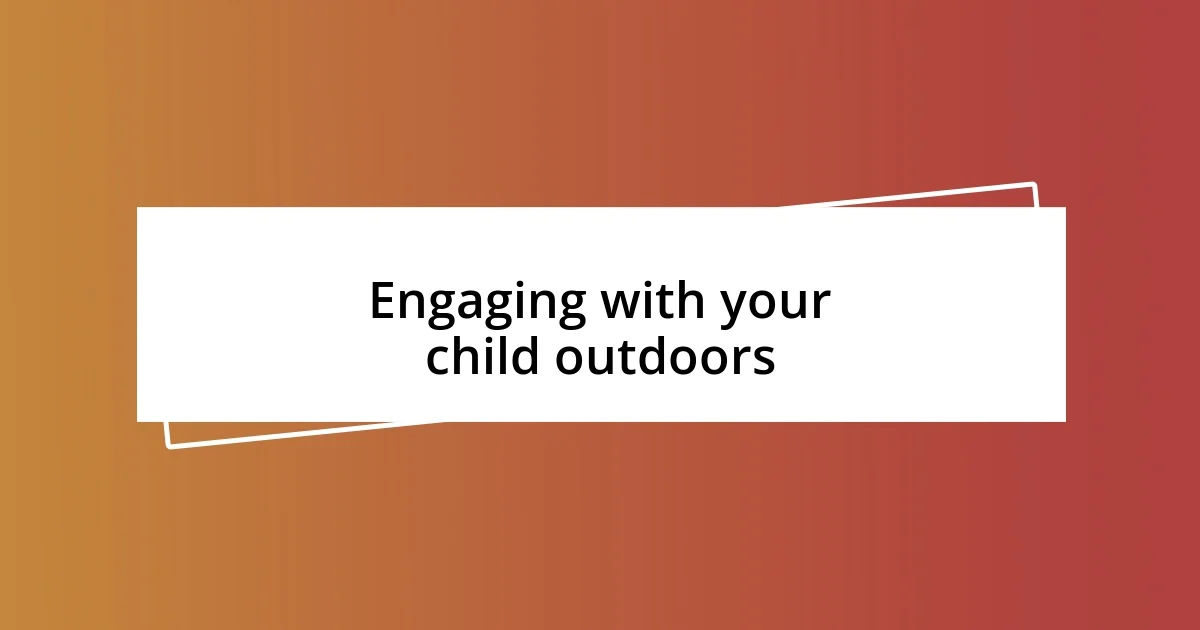
Engaging with your child outdoors
Engaging with your child outdoors can transform ordinary moments into memorable experiences. I remember one particular Saturday when we decided to visit a local park. My son was initially fixated on a swing, but I gently suggested we explore the nearby woods instead. As soon as we stepped off the path, his curiosity blossomed. “Look, Mom! A squirrel!” he exclaimed. Sharing in that excitement made me realize that sometimes it just takes a nudge to shift focus and find wonder in nature.
There are moments when simply being present can foster joyful interaction. I often find myself joining in on my child’s imaginative games, whether it’s pretending to be pirates searching for treasure or building a makeshift fort out of fallen branches. I recall an afternoon where we created a “space station” from old boxes. Laughing as we shouted, “We’re launching in 3… 2… 1!” made me feel like a kid again. Isn’t it delightful to lose yourself in play? These shared experiences not only create laughter but also deepen our bond.
I’ve learned that the best engagement sometimes comes from simply asking questions. Last week, while playing with a magnifying glass, I asked, “What do you think we’ll discover if we look closely at this leaf?” The sparkle in my daughter’s eyes said it all. She eagerly began examining the veins and tiny insects, fully immersed in her findings. Encouraging her curiosity this way helped her develop a sense of exploration. How often do we pause to wonder alongside our children? For me, it’s these little moments that make outdoor engagement truly special.
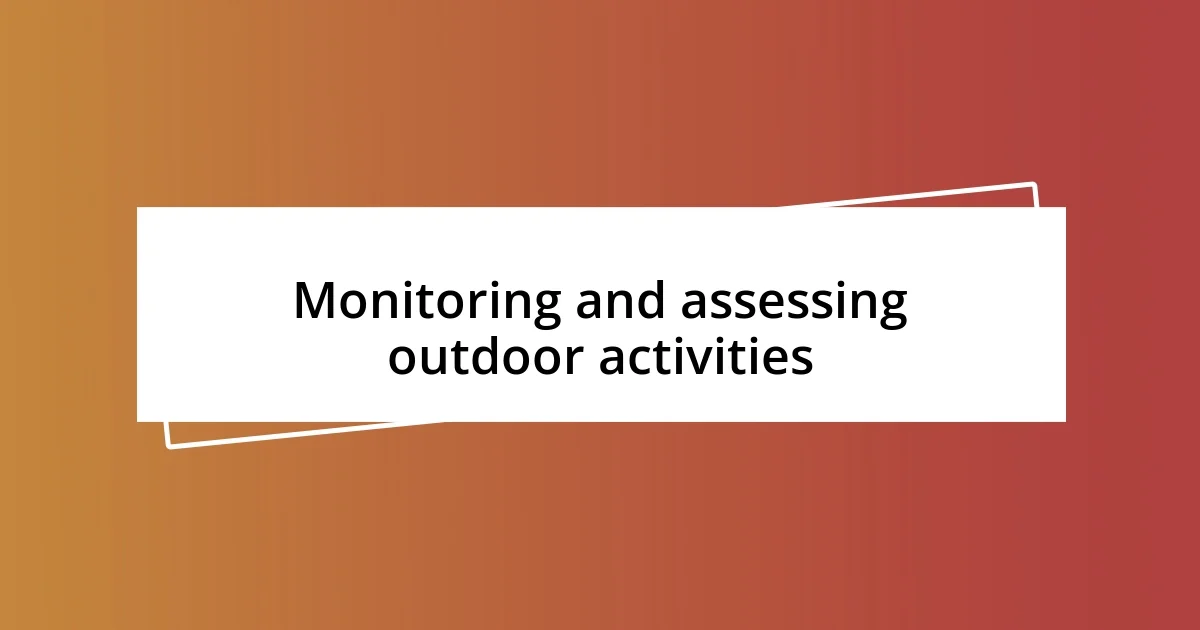
Monitoring and assessing outdoor activities
Monitoring outdoor activities is essential for both safety and growth. I often observe my child as they navigate different play scenarios, analyzing how they interact with their surroundings. One afternoon, I watched my son climb a tree. I felt a mix of pride and concern—it was impressive to see him challenge himself, but I also kept a close eye on his body language. When I noticed him hesitating on a branch, I called out gently, “How are you feeling up there?” His response helped me gauge whether he was confident enough to explore further or needed my support.
Assessing their activities goes beyond mere observation. I find that asking questions can provide insights into my child’s thought process. After an energetic day of biking, I asked, “What was the best part of your ride?” The gleam in his eyes told me everything—I could see that the thrill of speed and the joy of the wind on his face were key to his happiness. By engaging in this way, I not only monitor what they do but also understand the emotions tied to those experiences, reinforcing my child’s confidence and willingness to tackle new challenges.
Sometimes, I jot down notes after our outdoor adventures to reflect on their development. For example, after a family hike, I noted how my daughter eagerly helped to identify different plants. This simple act highlighted her growing connection to nature and sparked conversations about ecology and conservation. Assessing these moments helps me celebrate her progress and encourages me to structure future activities that align with her interests. Have you ever done something similar? It’s fascinating how reflecting on these experiences can enhance our perspective as parents while nurturing our children’s passion for the outdoors.










